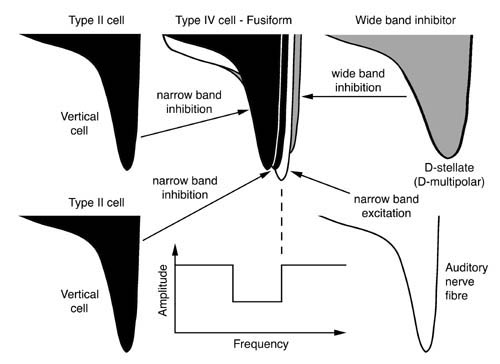
Chapter 6
Notes (17 August 2008)
P. 154: A further example, where information is initially analysed into separate channels and then recombined, concerns periodic stimuli such as trains of clicks. Because an auditory stimulus undergoes a mechanical frequency analysis immediately in the auditory periphery, the stimulus is initially split into many different frequency channels. Cross-frequency information is therefore not available in any one of the channels. Clicks are defined by having a wide spectrum, and one basic type of cross-frequency information is the rate of repetition of clicks, in cases where the clicks have been filtered to remove the energy at the fundamental repetition frequency. The wideband temporal information in the clicks is resynthesised by coincidence detection in the octopus cells of the posteroventral cochlear nucleus. These cells have a wideband frequency input, and can follow clicks up to a high rate of repetition. It is possible that these cells feed their information to those cells of the inferior colliculus where it has been suggested that the periodicity information is transformed into place information (see p. 275 and Fig. 9.6).
A further example where it is necessary to integrate information from many different types of analysis is that of detecting one voice in a crowd. This task involves the detection of spectral patterns, temporal patterns, sound localisation by time of arrival, and sound localisation by relative intensities of the sounds at the two ears. All of this information has to resynthesised to produce the representation of a single auditory object. (17 Aug 2008)P. 165: The figure below shows the interactions which give rise to the complex frequency response areas of Type IV cells in the dorsal cochlear nucleus, as shown in Figs 6.9 D and E of the text, and as suggested by E.D. Young and colleagues. Auditory nerve fibres synapsing with the Type IV fusiform cell (shown in the centre of the Figure) provide it with a sharply-tuned excitatory input (white). Type II units, i.e. vertical cells, with response areas that are slightly lower in frequency and higher in threshold than that arising from the afferent auditory nerve fibre, provide the fusiform cell with sharply tuned inhibition (black). In addition, relatively weak wideband inhibition (grey) of the fusiform cell arises from D-stellate (D-multipolar) cells plus another unknown source. These inputs together shape the fusiform cell’s response to give a narrow excitatory area at and just above the best frequency (white), plus an area of excitation in the low-frequency tail (white), but dominated by inhibition elsewhere (black and grey) (Young and Oertel, 2004). The graph at the centre shows the spectrum of the notch noise that drives these cells particularly strongly.

(17 Aug 2008).
Return to An Introduction to the Introduction to the Physiology of Hearing webpage